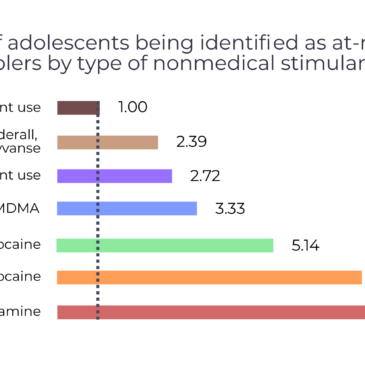In the United States approximately 882,000 adolescents experience gambling-related problems– a population roughly equivalent to the population of South Dakota. Researchers estimate that 1.3 million adolescents used stimulants nonmedically in the past-30-days. Studies of adult populations indicate that those who experience gambling-related problems are more likely than others to use nonmedical stimulant drugs such as cocaine or methamphetamine. This week, as part of our Special Series on Gambling Disorder, STASH reviews a study by Jérémie Richard and colleagues that explored how adolescent nonmedical stimulant use (NMSU) relates to experiences of gambling-related problems.
What is the research question?
Are adolescents who use stimulants nonmedically more likely than others to experience gambling-related problems? If so, which stimulants are most likely to be associated with these problems?
What did the researchers do?
The researchers used data from a survey1 of 6,542 public school students in grades 7 to 12 in Wood County, Ohio.2 Participants responded to questions about past-year NMSU, including powdered cocaine, crack cocaine, methamphetamine, Ritalin, Adderall, Concerta, Vyvanse, and MDMA. Participants responded to questions about gambling-related problems that covered loss of control over gambling, lying to conceal gambling behavior, and thinking a lot about gambling. The researchers used chi-square analyses to assess how NMSU behaviors relate to gambling-related problems.
What did they find?
Students with NMSU behaviors were nearly three times more likely than others to report gambling-related problems (see Figure). Use of methamphetamine and use of either powdered or crack cocaine were each associated with the greatest risk of experiencing gambling-related problems.

Figure. Numbers represent statistically significant odds ratios. Greater numbers indicate greater likelihood of being identified as at-risk/problem gambler than participants reporting no NMSU. Click image to enlarge.
Why do these findings matter?
Clinicians and youth addiction prevention organizations seeking to reduce adolescent risky behaviors like NMSU and gambling might fail if all problems are not properly identified during screening. Both of the behaviors assessed in this study should be included in a comprehensive screen for any adolescents reporting either behavior. These findings further suggest that adolescents reporting crack cocaine and methamphetamine use are an especially vulnerable population for experiencing gambling-related problems.
Every study has limitations. What were the limitations in this study?
The researchers only asked participants a few questions about NMSU and gambling-related problems, limiting our ability to better understand how to identify and treat adolescents experiencing these problems. Only one school district was screened for this study, which might affect the generalizability of this study. Adolescents in other areas with different backgrounds might experience different patterns of NMSU and gambling behaviors.
For more information:
Access free addiction help resources on The BASIS addiction resources page or call the national addiction helpline at 1-800-662-HELP (4357) for information on self-help resources. Your First Step to Change is a free self-help resource for those concerned about their gambling or smoking.
— Pat Williams
What do you think? Please use the comment link below to provide feedback on this article
________________
[1] Data were collected as part of the 2016 Alcohol, Drug Addiction and Mental Health Services Board/Wood County Education Service Center Survey on Alcohol and Other Drug Use.
[2] Participants were excluded from analysis if they did not report their gender or were under the age of 12.




